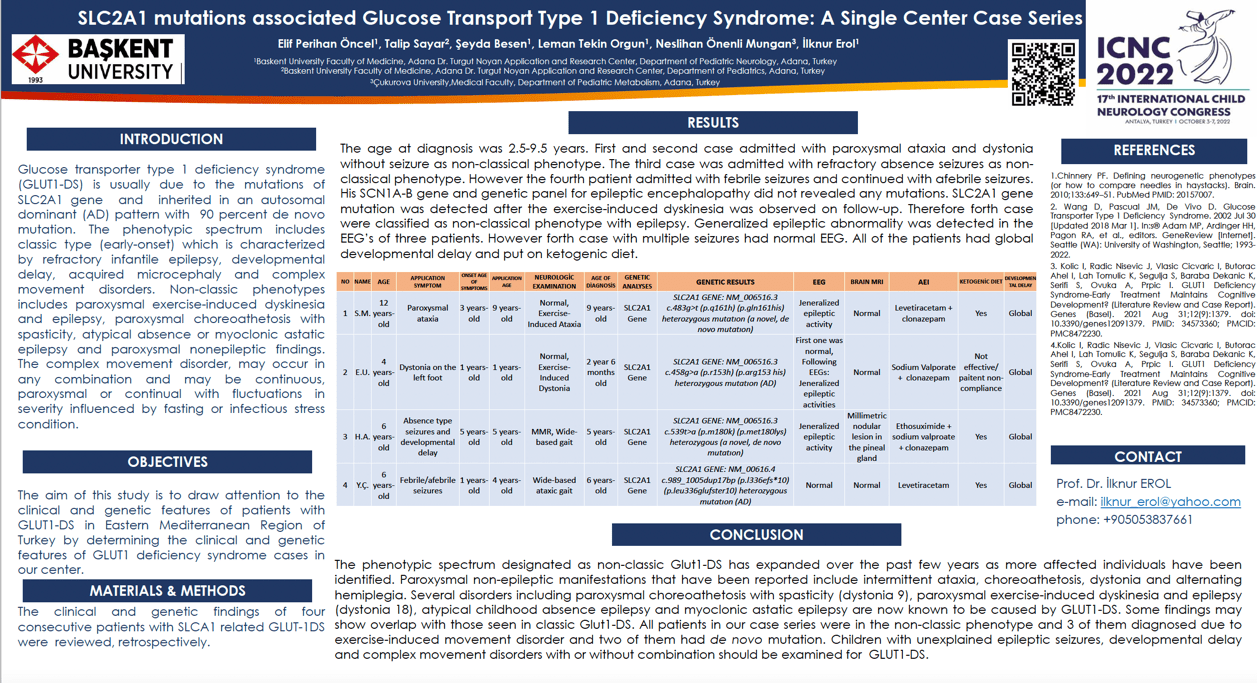SLC2A1 mutations associated Glucose Transport Type 1 Deficiency Syndrome: A Single Center Case Series
Elif Perihan Öncel , Talip Sayar, Şeyda Beşen, Leman Tekin Orgun, Neslihan Önenli Mungan, İlknur Erol
Objectives Glucose transporter type 1 deficiency syndrome(GLUT1-DS) is caused by heterozygous mutations of SLC2A1 gene Although classical phenotype (CP) is characterized by refractory infantile epilepsy,developmental delay,acquired microcephaly,and complex movement disorders. Non-classical phenotype is characterized by movement disorders as paroxysmal exercise-induced dyskinesia or choreathetosis and epilepsy as atypical absence or myoclonic astatic epilepsy. Methods The clinical and genetic findings of four consecutive patients with GLUT-1SD were retrospectively evaluated. Results The age at diagnosis was 2.5-9.5 years. First and second case admitted with paroxysmal ataxia and dystonia without seizure as non-classical phenotype. The third case was admitted with refractory absence seizures as non-classical phenotype. However the fourth patient admitted with febrile seizures and continued with afebrile seizures. His SCN1A-B gene and genetic panel for epileptic encephalopathy did not revealed any mutations. SLC2A1 gene mutation was detected after the exercise-induced dyskinesia was observed on follow-up. Therefore forth case were clasified as non-classical phenotype with epilepsy. Generalized epileptic abnormality was detected in the EEG’s of three patients. However forth case with multiple seizures had normal EEG. All of the patients had global developmental delay and put on ketojenic diet. Conclusion All patients in our case series were in the non-classical phenotype and 3 of them diagnosed due to exercise-induced movement disorder. Children with unexplained epileptic seizures, developmental delay,and complex movement disorders with or without combination should be examined for GLUT1-DS.
Keywords: GLUT1, GLUT-1SD, SLC2A1, absence, epileptic seizure, movement disorders
Elif Perihan Öncel
Baskent University Faculty of Medicine, Adana Dr. Turgut Noyan Application and Research Center
Turkey
Talip Sayar
Baskent University Faculty of Medicine, Adana Dr. Turgut Noyan Application and Research Center
Turkey
Şeyda Beşen
Baskent University Faculty of Medicine, Adana Dr. Turgut Noyan Application and Research Center
Turkey
Leman Tekin Orgun
Turkey
Neslihan Önenli Mungan
Cukurova University, Faculty of Medicine
Turkey
İlknur Erol
Baskent University Faculty of Medicine, Adana Dr. Turgut Noyan Application and Research Center
Turkey
Objectives Glucose transporter type 1 deficiency syndrome(GLUT1-DS) is caused by heterozygous mutations of SLC2A1 gene Although classical phenotype (CP) is characterized by refractory infantile epilepsy,developmental delay,acquired microcephaly,and complex movement disorders. Non-classical phenotype is characterized by movement disorders as paroxysmal exercise-induced dyskinesia or choreathetosis and epilepsy as atypical absence or myoclonic astatic epilepsy. Methods The clinical and genetic findings of four consecutive patients with GLUT-1SD were retrospectively evaluated. Results The age at diagnosis was 2.5-9.5 years. First and second case admitted with paroxysmal ataxia and dystonia without seizure as non-classical phenotype. The third case was admitted with refractory absence seizures as non-classical phenotype. However the fourth patient admitted with febrile seizures and continued with afebrile seizures. His SCN1A-B gene and genetic panel for epileptic encephalopathy did not revealed any mutations. SLC2A1 gene mutation was detected after the exercise-induced dyskinesia was observed on follow-up. Therefore forth case were clasified as non-classical phenotype with epilepsy. Generalized epileptic abnormality was detected in the EEG’s of three patients. However forth case with multiple seizures had normal EEG. All of the patients had global developmental delay and put on ketojenic diet. Conclusion All patients in our case series were in the non-classical phenotype and 3 of them diagnosed due to exercise-induced movement disorder. Children with unexplained epileptic seizures, developmental delay,and complex movement disorders with or without combination should be examined for GLUT1-DS.
Keywords: GLUT1, GLUT-1SD, SLC2A1, absence, epileptic seizure, movement disorders
Elif Perihan Öncel
Baskent University Faculty of Medicine, Adana Dr. Turgut Noyan Application and Research Center
Turkey
Talip Sayar
Baskent University Faculty of Medicine, Adana Dr. Turgut Noyan Application and Research Center
Turkey
Şeyda Beşen
Baskent University Faculty of Medicine, Adana Dr. Turgut Noyan Application and Research Center
Turkey
Leman Tekin Orgun
Turkey
Neslihan Önenli Mungan
Cukurova University, Faculty of Medicine
Turkey
İlknur Erol
Baskent University Faculty of Medicine, Adana Dr. Turgut Noyan Application and Research Center
Turkey

Patient Y.Ç
Patient EU
Patient SM
Patient HA
Elif Perihan Öncel
Baskent University Faculty of Medicine,
Adana Dr. Turgut Noyan Application and Research Center
Turkey
Baskent University Faculty of Medicine,
Adana Dr. Turgut Noyan Application and Research Center
Turkey